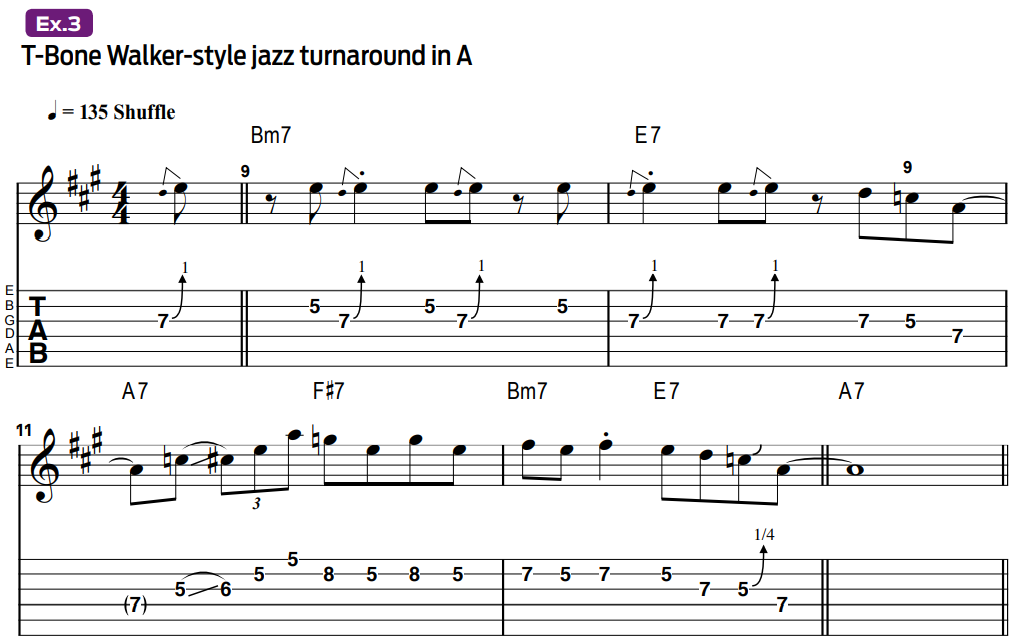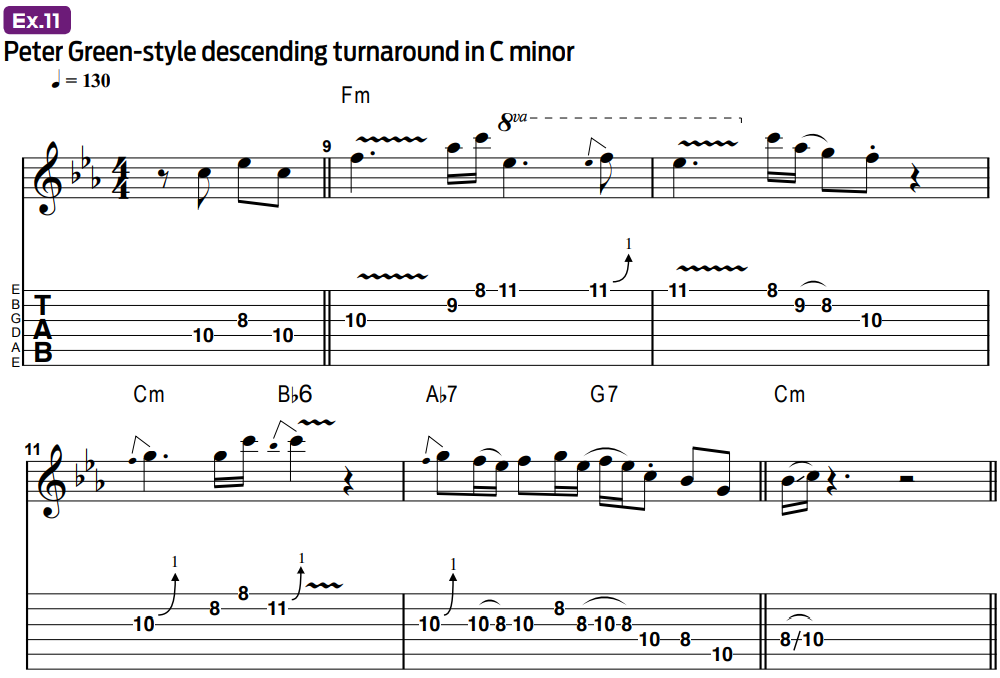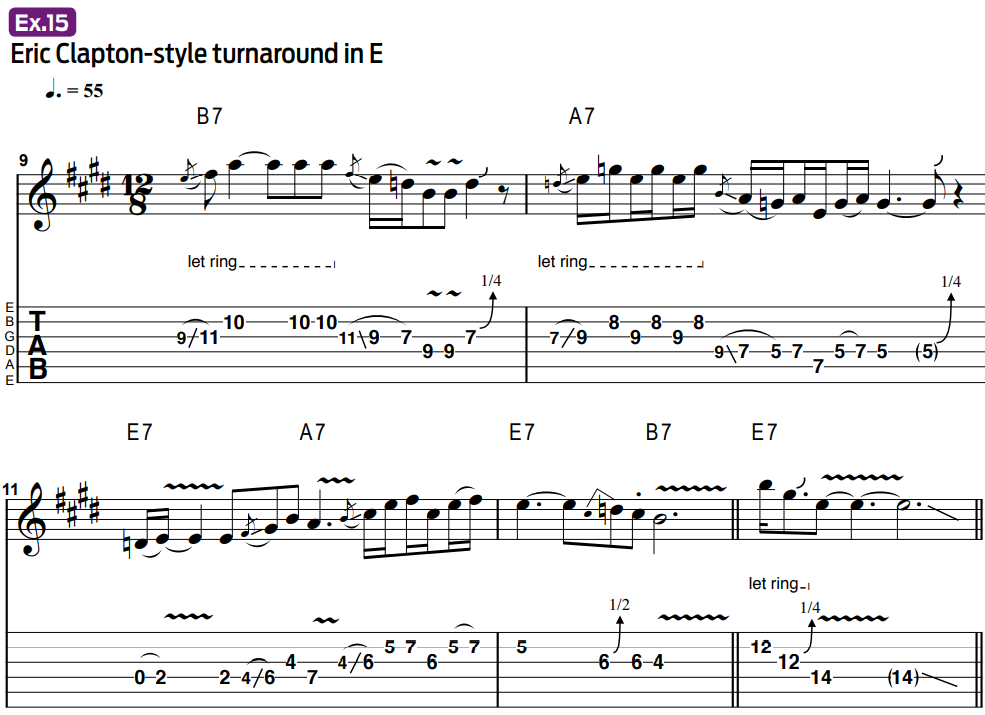Blues Turnarounds (Part 1)
How to play soulful, harmonically effective melodies over the last four bars of a blues progression in the styles of the genre’s greatest players.

As its name suggests a blues turnaround is a section of music that comes at the end of a verse, giving it harmonic interest and resolution and leading the song back to the start of a new verse, which is almost always a repeat of the first, in terms of form.
Generally speaking, a turnaround occurs in the last two bars of a blues or jazz standard, whether it’s an eight-, 12-, 16-, 24- or 32-bar form. In the context of a standard 12-bar blues progression, the melody generally concludes at the beginning of the 10th bar, so instead of simply sitting on the tonic, or “one,” chord for two more bars, a chordal turnaround is inserted in bars 11 and 12 to maintain interest and forward momentum and create a strong setup for a repetition and “looping” of the progression.
Turnaround licks are typically improvised and are generally built around the framework of four chords (two per bar), usually I-IV-I-V but sometimes the jazzier I-VI-ii-V (lowercase Roman numerals indicate minor-type chords). As you’ll see in this lesson, there are many variations on these two basic forms.

The chord types may be diatonic or non-diatonic (based on the parent scale of the key, or not) and are also influenced by the style of blues (major versus minor). It’s generally understood that professional players will be familiar with the harmonic intricacies generated by the many permutations of these two basic forms.
In both parts of this two-part lesson, we’ll study lead licks played over blues guitar turnarounds in the styles of 10 of the genre’s most influential players of all time. Each player will be represented with three examples that cover major and minor keys, and because some licks can often be interchanged between major and minor keys, our examples will start on the same root note and feature a range of grooves and tempos.
Instead of illustrating the turnaround in isolation, the examples are presented as they would occur in the last four bars of a 12-bar blues progression – bars 9 through 12. And because turnarounds are also frequently used as intros, these examples can also serve as useful ways to kick off a song or guitar solo in a blues tune.

Because turnarounds customarily occur at the end of the vocal melody, they provide a clear space and musical opening that the guitarist can fill, whether they’re soloing or not. Not surprisingly, different players have their own approach to turnarounds. Some plow through the changes with pentatonic-based ideas, taking little heed of the chords, while others carefully target notes in each underlying chord to create a melodic shape.
All the latest guitar news, interviews, lessons, reviews, deals and more, direct to your inbox!
It takes practice to deftly negotiate this sequence and make your playing sound relaxed and casual, but the time spent doing so will improve your improvisational and soloing skills tremendously. The turnaround contains all the chords of the blues but in condensed form, so you really need to keep on top of the changes and nail those target notes.
Technique Focus: Scale Choices
To get the most out of this lesson, make sure you can play these scales in all five CAGED positions and familiarize yourself with the suggested applications.

MINOR PENTATONIC: R-b3-4-5-b7
Use this form in the I-chord position over the I, IV and V chords. It can also be transposed to start on the root of the V chord but can only be transposed to the root of the iv chord in a minor key. Also, you can freely add the blues-scale’s b5 passing tone to this scale.
MIXOLYDIAN MODE: R-2-3-4-5-6-b7
Use in tonic position over the I chord. It can also be transposed to the IV and V chords.
MAJOR PENTATONIC: R-2-3-5-6
Use in tonic position over I and V. It can also be transposed to the IV chord. Also, you can freely add the blues-scale’s b5 passing tone to this scale, as the b3.
PHRYGIAN-DOMINANT MODE: R-b2-3-4-5-b6-b7
Play this scale over the V or V7 chord in a minor key. This is the harmonic minor scale’s fifth mode and is the same as playing the tonic harmonic minor scale of that key.
THE B.B. KING “BLUES BOX”: R-2-4-5-6
Use in tonic position over all chords, but bend the B string only a half step when playing over the IV chord.
SUPER-LOCRIAN MODE: R-b2-b3-3-b5-b6-b7
Use in root position over an altered-dominant chord, such as 7b9, 7#9, 7b5, 7#5, or any combination of these. This is the same as playing the melodic minor scale rooted a half step above the altered[1]dominant chord’s root.

Let’s begin with a T-Bone Walker–style lick played over a I-IV-I-V turnaround in the key of G (G7 C9 G7 D7aug). T-Bone’s jazzy and harmonically adept style has influenced countless players, and echoes of his pioneering approach can be heard in the playing of guitarists ranging from Chuck Berry to Jimmy Page.
Walker’s solos frequently featured the major second (or ninth) and major sixth from the Mixolydian mode (in this case, the notes A and E from G Mixolydian: G A B C D E F), as demonstrated in bars 9 and 12 of Ex. 1. Notice that the minor third, relative to G, Bb, is played over, and only over, the IV chord, where it effectively highlights the b7 of C9.

Walker’s style also informs the i-iv-i-V minor turnaround in the key of A minor shown in Ex. 2. Here, the IV chord is dominant in bar 10 (D9) but minor (iv, Dm) in bar 11, during the turnaround. To avoid any harmonic clashes, you can play the tonic A minor pentatonic scale (A C D E G) over both incarnations of the IV chord, as demonstrated here.
That unusual lick in the first bar is created by applying an augmented triad to the root of the V chord and then ascending in whole tones, referencing the whole-tone scale) This is a harmonically sophisticated idea and showcases T-Bone’s musical depth.

Presented in the key of A major, Ex. 3 offers a phrase played over a jazzy I-VI-ii-V turnaround in T-Bone’s style. To negotiate the more complex chord movement in this example, the A Mixolydian mode (A B C# D E F#G) is extended over the dominant VI chord (F#7) to imply an F#7b9 sound (via the note A), which is a move frequently employed by jazz guitarists, such as T-Bone’s contemporary back in the 1940s, the great Charlie Christian.
In bar 12, the fifth of the ii chord, Bm7 (E) is highlighted, followed by a walk down the A minor pentatonic scale over the E7 chord, which includes what would be the #5 tension tone of that chord, C (or B#).

The great B.B. King is another blues guitarist celebrated for his impeccable note choices and phrasing. B.B.’s signature go-to pattern was a hybrid major-/minor-pentatonic “blues box,” which is based around the root note of the song’s key (typically played on the B string), with the major sixth played below it and the major second, perfect fourth and perfect fifth played above it. The guitarist would typically bend the major second up a half step to the minor third, or up a whole step to the major third, and would also often bend the fifth up a whole step to the major sixth, or one and one half steps to the minor seventh. In so doing, the guitarist would greatly expand his palette of note choices and musical colors.

Ex. 4 features King-style licks played over the final four bars of a 12-bar blues in the key of Bb, with a harmonically complex bass-line “walk-up” turnaround in bars 11 and 12 that features the use of a first-inversion chord and a diminished seven, but this can be approached as a more straightforward I-IV-I-V turnaround.

Ex. 5 offers an example of how B.B. would solo over the last four bars of a minor blues progression in the key of B minor that includes a i-bVI-ii-V turnaround (Bm Gmaj7 C#m7b5 F#7#9). The bVI chord (in this case, Gmaj7) is commonly encountered in a minor blues progression; it can be either major (with or without the major seventh) or dominant, but never minor.
This entire turnaround is skillfully negotiated by hitting just the right “color tones” over each chord, all achieved in this example with just the B minor pentatonic scale (B D E F# A), with the major second, C#, added, which is borrowed from the B Dorian mode (B C# D E F# G# A).

B.B. also had a penchant for occasionally beginning a turnaround lick before the turnaround begins, as in bar 10 of Ex. 6, which leads into a jazz-flavored I-VI-ii-V turnaround in the key of Bb major (Bb7 G7 Cm7 F7).
The turnaround phrase begins by chromatically encircling the third of the tonic Bb chord, D. This creates tension, which is resolved perfectly on beat one of bar 11 by landing squarely on the Bb root note. In bar 12, the tonic major arpeggio, Bb, flows into a chromatically descending blues-scale phrase (resolving on Eb, the b7 of F7), which beautifully outlines the Cm7-F7 chord change.

The legendary Albert King was famed for his wide, howling “over-bends” of a minor third (equal to three frets) and sometimes a major third (equal to four frets) and fiery delivery, as exemplified in the line played in the key of C over Ex. 7’s descending I-I7-IV-iv-I-V turnaround. The apparent complexity of this six-chord sequence can be approached as a more basic I-IV-I-V turnaround and negotiated with nothing more than the tonic C blues scale (C Eb F Gb G Bb), as demonstrated here.

The minor pentatonic or blues scale (which additionally includes the b5) can indeed almost always be applied as a blanket approach over an entire turnaround sequence, but it is only really effective when the relevant chord tones are targeted, as demonstrated in Ex. 8, an Albert King-style i-iv-i-V turnaround in the key of C minor.
Notice how the phrasing here is always anticipating the chord changes. This is the only way to achieve slick and musical results. Albert is often thought of as a “simplistic” player, but this clear sophistication belies that view.

Played in the key of C major, Ex. 9 is another Albert-inspired turnaround phrase, one that illustrates an even looser approach to the basic I-IV-I-V turnaround. Here, a strong C minor pentatonic (C Eb F G Bb) lick is forced over the sequence and resolves satisfyingly to the V chord, G7.
This approach exemplifies a great way to start getting your turnaround chops together. Simply think of the sequence as a bar and a half on the I chord followed by two beats on the V, but be sure to anticipate the resolution to the V chord, as shown here. A “late” resolution – meaning on the beat – will just sound wrong in this context!
Peter Green was a precocious master of the blues. His signature finger vibrato and controlled phrasing were already fully developed by the time he joined John Mayall’s backing group, the Bluesbreakers, at the tender age of 19.

The melodic lick played in the key of C minor over the descending i-iv-i-v-i-V7 descending turnaround in Ex. 10 illustrates how adept Green’s approach was when dealing with a complex minor-key turnaround such as this (with the use of both minor and dominant V chords and inversions), using nothing more than the tonic minor pentatonic scale, in this case C minor pentatonic.

Also in the key of C minor, Ex. 11 offers another Green-style lead phrase, this one played over two bars on the iv chord, Fm, followed by a i-bVII-bVI-V turnaround: Cm Bb6 Ab7 G7 Cm. The chromatic bVI7-V7 chord sequence (Ab7 G7) is very common in minor turnarounds but can be approached as a regular i-V7 sequence since the bVI chord shares critical notes with the tonic minor chord, namely the root and minor third.
Notice how the C minor pentatonic melody is used to generate altered-dominant tensions over the all-important G7 chord in bar 12, with the tonic note, C, phrased on the upbeat. Green really knew how to nail a solo!

The blues scale contains the über-cool b5 interval, a note that is all too frequently employed merely as a passing note for creating fast licks. In Ex. 12’s I-I7-IV-iv-I-V turnaround in the key of C (C7 C7/Bb F/A Fm/Ab C/G G7), inverted chords are used to create an pleasingly effective descending harmony line. Notice also how the phrase effectively resolves to the V chord, G7, illustrating total rhythmic and harmonic control.
Let’s wrap up this first half of our lesson with three examples in the style of the great Eric Clapton, Green’s Bluesbreakers predecessor. Clapton’s blues playing with the Bluesbreakers in the mid-’60s demonstrated a deep understanding of the genre that belied his youth and suburban background. His phrasing has always been impeccable, infused with fiery licks and B.B. King-style “thumb off the neck” finger vibrato.

In Ex. 13, the climbing bass line of a I-I7-IV-#IVdim-I-V7 turnaround in the key of E (E E7/G# A A#dim7) is juxtaposed by a contrary-motion descending melody line, resolving tidily to the V chord, B7.

Oblique unison bends figured prominently in Clapton’s early soloing style, and they’re featured in bar 11 of Ex. 14, at the start of a i-iv-i-V-i minor turnaround in the key of E minor. This simple lick is typical of Clapton’s economical phrasing style, outlining the four turnaround chords with precision and clarity.

Played in the key of E major, our final Clapton-style example, Ex. 15, illustrates the effectiveness of the major pentatonic scale, in this case E major pentatonic (E F# G# B C#) when applied to a I-IV-I-V turnaround sequence.
Notice how the fourth, A, borrowed from the parallel E minor pentatonic scale, is added to provide the root of the IV chord, A7, on beat three of bar 11. It’s important to note here that you should avoid playing the tonic major third (in this case, G#) over the IV chord (A7, in this case), as doing so creates an unpleasant harmonic clash.
Next time, we’ll finish up our lesson with a fresh batch of blues turnaround lick and phrases in the styles of Carlos Santana, Gary Moore, Stevie Ray Vaughan, Robben Ford and Larry Carlton. See you then!
